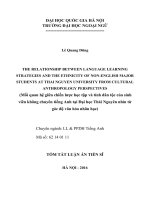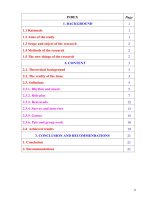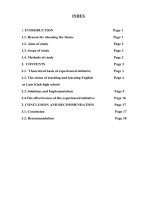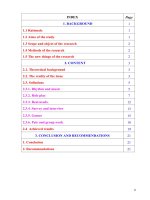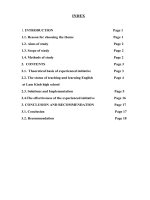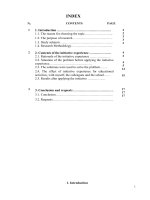The difficulties of elementary students when doing oral presentation in a speaking lesson a case of an english center in hanoi
Bạn đang xem bản rút gọn của tài liệu. Xem và tải ngay bản đầy đủ của tài liệu tại đây (1.24 MB, 70 trang )
VIETNAM NATIONAL UNIVERSITY, HANOI
UNIVERSITY OF LANGUAGES AND INTERNATIONAL STUDIES
FACULTY OF POST-GRADUATE STUDIES
NGUYỄN THU THẢO
THE DIFFICULTIES OF ELEMENTARY STUDENTS WHEN
DOING ORAL PRESENTATION IN A SPEAKING LESSON: A
CASE OF AN ENGLISH CENTER IN HANOI
(Những khó khăn của học sinh tiểu học khi làm bài thuyết trình trong
giờ học nói: Một nghiên cứu tại một trung tâm tiếng Anh ở Hà Nội)
M.A. MINOR PROGRAM THESIS
Major: Teaching English Methodology
Code: 8140231.01
HANOI – 2019
VIETNAM NATIONAL UNIVERSITY, HANOI
UNIVERSITY OF LANGUAGES AND INTERNATIONAL STUDIES
FACULTY OF POST-GRADUATE STUDIES
NGUYỄN THU THẢO
THE DIFFICULTIES OF ELEMENTARY STUDENTS WHEN
DOING ORAL PRESENTATION IN A SPEAKING LESSON: A
CASE OF AN ENGLISH CENTER IN HANOI
(Những khó khăn của học sinh tiểu học khi làm bài thuyết trình trong giờ
học nói: Một nghiên cứu tại một trung tâm tiếng Anh ở Hà Nội)
M.A. MINOR PROGRAM THESIS
Major: Teaching English Methodology
Code: 8140231.01
Supervisor: Hoàng Thị Xuân Hoa, Ph.D
HANOI – 2019
DECLARATION
I certify that the work presented in this research report has been performed
and interpreted solely by myself. I confirm that this paper is submitted in fulfillment
of the requirement for the M.A. Degree and has not been submitted elsewhere in
any other form for the fulfillment of any other degree or qualification.
Hanoi, 2019
Nguyễn Thu Thảo
i
ACKNOWLEDGEMENTS
This M.A thesis could not have been accomplished without the invaluable
help, encouragement and support form a number of people who I would like to
show my sincerest gratitude and appreciation.
To begin with, I would like to express my greatest and deepest thankfulness
to Doctor Hoàng Thị Xuân Hoa, my supervisor, for her enthusiastic and precious
guideline and advice throughout the duration of my thesis. Without her instruction
and supervision, this thesis could not have reached the fulfillment.
Moreover, my honest thanks also come to teachers and students in an English
center in Hanoi, especially teachers and students who participated in my research.
Last but not least, I owe a great debt of gratitude to my family and relatives who have
always supported me and supplied the best conditions for me to complete this thesis.
ii
ABSTRACT
Among four skills of English language, speaking has been claimed to be an
important skill to communicate. Oral presentation takes an important role in
teaching and learning English, especially in teaching and learning English speaking
skill. However, many students find it difficult to do a presentation. This study was
conducted to explore the difficulties of elementary students when doing oral
presentation in a speaking lesson in an English center in Hanoi. This study also
collects students‟ expectation of their teachers to solve the problem. 100 elementary
students in an English center in Hanoi, who have to do oral presentation in speaking
lessons as one task in their course, participated in this research. Questionnaire,
observation, and interview were employed to collect data for the research. The
findings of this study revealed that there are many difficulties faced by elementary
students in doing presentation. Among these difficulties, “Language”, "Personal
trait" and “External factor” constitute the most serious difficulties encountering
students in the process of delivering oral presentation. On the basis of the findings
of this study and in the light of the difficulties encountering students in giving the
oral presentation, the students expect some supports from their teachers to
overcome these difficulties and to improve the learning process generally in oral
proficiency and speaking skill in particular.
iii
TABLE OF CONTENTS
DECLARATION ..................................................................................................................... i
ACKNOWLEDGEMENTS.................................................................................................. ii
ABSTRACT ............................................................................................................................ iii
TABLE OF CONTENTS ..................................................................................................... iv
LIST OF TABLES ................................................................................................................. vi
LIST OF FIGURES.............................................................................................................. vii
PART I: INTRODUCTION ................................................................................................. 1
1. Rationale of the study ........................................................................................................... 1
2. Research aims ........................................................................................................................ 2
3. Research questions ................................................................................................................ 2
4. Scope of the study ................................................................................................................. 2
5. Methods of the study............................................................................................................. 3
6. Significance of the study ...................................................................................................... 3
7. Design of the thesis ............................................................................................................... 3
PART II: DEVELOPMENT ................................................................................................ 5
CHAPTER 1: LITERATURE REVIEW .......................................................................... 5
1.1. Oral presentation ................................................................................................................ 5
1.1.1 Definition of oral presentation ........................................................................................ 5
1.1.2. Types of oral presentation .............................................................................................. 6
1.1.3. Significance of oral presentation ................................................................................... 7
1.2. Learning difficulty ............................................................................................................. 8
1.2.1. Definition of learning difficulty..................................................................................... 8
1.2.2. Classification of learning difficulties ............................................................................ 9
1.2.3. Students‟ difficulties in oral presentation ................................................................... 10
1.3. Young learners ................................................................................................................. 11
1.3.1. Characteristics of young learners ................................................................................ 11
1.3.2. Factors causing young learners‟ difficulties when presenting .................................. 13
1.4. Related studies .................................................................................................................. 14
1.5. Summary ........................................................................................................................... 16
iv
CHAPTER 2: RESEARCH METHODOLOGY........................................................... 17
2.1. Research design ................................................................................................................ 17
2.2. Research subjects ............................................................................................................. 18
2.3. Data collection instruments ............................................................................................. 18
2.3.1. Questionnaire................................................................................................................. 19
2.3.2. Observation.................................................................................................................... 20
2.3.3. Interview ........................................................................................................................ 21
2.4. Data collection procedure................................................................................................ 22
2.5. Data analysis procedure................................................................................................... 22
2.6. Summary ........................................................................................................................... 23
CHAPTER 3: FINDINGS AND DISCUSSION ............................................................. 24
3.1. Data collected from the questionnaire............................................................................ 24
3.1.1. Students‟ difficulties in doing presentation ............................................................... 24
3.1.2. Students‟ expectation of their teachers to help them overcome the difficulties ..... 31
3.2. Data collected from observation ..................................................................................... 36
3.3. Data collected from interview......................................................................................... 38
3.4. Summary ........................................................................................................................... 41
CHAPTER 4: CONCLUSION........................................................................................... 42
4.1. A summary of the major findings................................................................................... 42
4.2. Implications of the study ................................................................................................. 43
4.3. Limitations of the study ................................................................................................... 43
4.4. Recommendations for further study ............................................................................... 44
REFERENCES ...................................................................................................................... 45
APPENDIX................................................................................................................................ I
APPENDIX 1 ............................................................................................................................ I
APPENDIX 2 ......................................................................................................................... IV
APPENDIX 3 ....................................................................................................................... VII
APPENDIX 4 ......................................................................................................................... IX
APPENDIX 5 .......................................................................................................................... X
v
LIST OF TABLES
Table 3.1: The sum of responses, means, std. deviation and the rank of each item from of
the first domain from the questionnaire................................................................................. 24
Table 3.2: The sum of responses, means, std. deviation and the rank of each item from of
the second domain from the questionnaire ........................................................................... 25
Table 3.3: The sum of responses, means, std. deviation and the rank of each item from of
the third domain from the questionnaire ............................................................................... 26
Table 3.4: The sum of responses, means, std. deviation and the rank of each item from of
the fourth domain from the questionnaire ............................................................................. 27
Table 3.5: The sum of responses, means, std. deviation and rank of each domain from
and all questionnaire................................................................................................................ 28
Table 3.6: The sum of responses, means, std. deviation and rank of each item from of the
second part from the questionnaire ........................................................................................ 31
vi
LIST OF FIGURES
Figure 3.1: Teachers give more interesting and useful topics. ........................................... 32
Figure 3.2: Teachers give detailed guide about how to make a good presentation. ........ 33
Figure 3.3. Teachers give better score or a reward for the best presentation..................... 33
Figure 3.4: Teachers help brainstorming some ideas that can appear in the presentation.
................................................................................................................................................... 34
Figure 3.5: Teachers provide some activities to make students able to use language
without fear to make mistakes................................................................................................ 35
vii
PART I: INTRODUCTION
1. Rationale of the study
Since English was first taught in Vietnam, learners had focused more on
studying grammar and translation because they were the best ways to communicate
with foreigners and set foot to the English-speaking world. However, nowadays, as
the society is developing faster, it is required that education should attach special
importance to communicative language teaching. Therefore, speaking plays an
important role in learning English. There are many ways for English learners to
improve their speaking ability, one of which is oral presentation.
Applying oral presentations nowadays in teaching is not uncommon. The use
of oral presentations in teaching, especially in teaching English, has created a new
trend in the field of English language teaching methodology, which has drawn a lot
of researchers‟ attention all over the world (Miles, 2003). It is believed that the
opportunity to speak in front of the audience is one of the greatest benefits that
students are offered when spending time at school (Miles, 2003). Zhu (2005) shared
her same opinion about the need of using presentation in developing student skills.
She claimed in her study that oral presentation is a multi-task activity requiring
learners to speak and illustrate their speech at the same time. It has two clear
purposes which are to provide information and/ or to persuade listeners to do a
desired task. Nowadays, as presentation becomes more popular, it takes an
important role in teaching and learning.
Numerous studies have examined the factors contributing to the success of
oral presentations (Cheung, 2008; Taylor, 2012; Wilson and Brooks, 2014), the
general benefits of using presentation in EFL classrooms, and the teachers‟ and
students perceptions of the effects of this technique on the development of the
language skills and language elements (i.e. pronunciation, grammar, and
vocabulary) (Nguyen, 2012; Masmaliyev, 2014). However, very few studies have
been carried out to measure the difficulties of elementary students when doing oral
presentation in a speaking lesson. In fact, a thorough search in the literature results
1
in no study carried out to investigate the difficulties of elementary students when
doing oral presentation in a speaking lesson in the context of Vietnam. This is the
first reason why the researcher wanted to do research on this topic.
Realizing the effects of using oral presentations in EFL lessons on the
students‟ language development, all learners including elementary students in an
English center in Hanoi have to do oral presentation as one task in their courses,
which showed that the center really emphasizes on the importance of presentation in
class. In fact, not only elementary students find it difficult to do a presentation, even
intermediate learners find it difficult to improve their presentation skill although
they have practiced regularly. Being a teacher in this center, the researcher
considered this a very good chance for her to carry out a study on the difficulties of
elementary students when doing oral presentation in a speaking lesson.
The above reasons are the main ones for the birth of the study entitled “The
difficulties of elementary students when doing oral presentation in a speaking
lesson: A case of an English center in Hanoi”, which is hopefully useful for all
levels of students in general and elementary students in particularly.
2. Research aims
This research‟s main aim is to explore the difficulties of elementary students
when doing oral presentation in a speaking lesson in an English center in Hanoi.
This study also collects students‟ expectation of their teachers to solve the problem.
3. Research questions
The above overall aim is expected to be fulfilled by addressing the following
research questions:
Question 1: What are the difficulties faced by elementary students in doing
presentation?
Question 2: What do students expect from their teachers to help them overcome the
difficulties?
4. Scope of the study
The subjects of this study are elementary students in this center. All the students
have experienced oral presentation in class. The study focuses on finding out the
difficulties of these students when doing oral presentation in a speaking lesson.
2
5. Methods of the study
In this study, the data was collected by multiple methods which are
observation, face-to-face questionnaire and interview. Questionnaire and interview
were used to achieve a reliable and comprehensive picture. In addition, observation
was used for being objective. After analyzing the data, some conclusions were
drawn.
6. Significance of the study
This study mainly focuses on the difficulties of elementary students when
doing oral presentation in a speaking lesson. Findings of the study are hoped to help
students, especially elementary students in this center in developing the oral
presentation. Firstly, it could be a guide for students, especially elementary students
in this center in developing the oral presentation. Secondly, the research helps
students understand clearly about the difficulties when doing oral presentations.
Therefore, it can change students‟ attitude and behaviors toward studying. Finally,
the study increases students' interest in presentation since they can find suitable
ways to overcome these difficulties. The study is also hoped to fill the gap in the
literature on the level of the difficulties of elementary students when doing oral
presentation in a speaking lesson in the context of Vietnam. Other researchers who
are interested in doing research in the topic can use this study as a reference to carry
out their investigation.
7. Design of the thesis
This study consists of four chapters:
Introduction presents the rationale for conducting the study along with its aims,
research questions, significance and design.
Chapter 1 - Literature Review conceptualizes the framework of the study including
the key concepts such as the definition of oral presentation, its types and
significance in EFL classrooms, the definition of difficulty, its classification,
students‟ difficulties in presentation, characteristics of young learners and factors
hindering young learners‟ from presenting. A brief overview of the related studies
are also provided.
3
Chapter 2 - Research methodology presents the context, the methodology used in
this study including the objects, data collection instruments, data collection
procedure and analysis.
Chapter 3 – Findings and discussion presents a comprehensive analysis of the data
and gives discussion on the findings of this study.
Chapter 4 – Conclusion offers the summary of findings, implications, limitations,
and recommendations for further study.
4
PART II: DEVELOPMENT
CHAPTER 1: LITERATURE REVIEW
This chapter conceptualizes the framework of the study including the key
concepts such as the definition of oral presentation, its types and significance in
EFL classrooms, the definition and classification of difficulty, students‟ difficulties
in presentation, characteristics of young learners and factors hindering young
learners‟ from presenting. A brief overview of the related studies are also provided.
1.1. Oral presentation
1.1.1 Definition of oral presentation
According to Kaul (2005, p.2), “presentations are ideas, concepts or issues
that are talked about or shared with a group of people or an audience”. It can be
stated that an oral presentation is not limited to those given to a large audience; it
can be considered as a means by which people can communicate daily in a
workplace, teach in the classroom, give opinions and express oneself in a situation
that requires explanation in clear and precise speeches. Studying this field,
researchers have found that this kind of activity is associated with expressing ideas.
Hyland (1991) claimed that the oral presentation is regularly a partly spoken,
partly visual form of communication which is intended to inform or convince and
occurs in organizational settings. Time is typically constrained thus the successful
presentation must be carefully arranged. The speaker must make certain of her facts
and objectives, have a carefully structured outline, support her presentation with
visual aids, convey the talk clearly and confidently and afterward handle inquiries
from the floor. Obviously this is a fairly requesting exercise but it is achievable with
a consciousness of oral communication skills and the practical experience of how
they might bc connected.
Delivering oral presentations in English is not only a straightforward matter
of learning language and following guidelines but also a skill requiring complex
sociolinguistic and in addition cognitive understandings, particularly for learners of
5
English as an Additional or Foreign Language (EAL/EFL) (Morita, 2000; Adams,
2004). Melion and Thompson (1980, p.503) stated that if oral presentation is guided
and organized, it will give the students a learning experience and teach them an
important skill which will be beneficial to ESL/EFL in all their education subject
and later in their work. According to Chivers and Shoolbred (2007, p.5), “doing
presentation is very good learning experience.” In addition, Mandal (2000, p.8)
stated, “presentations are speech that is usually given in a business, technical,
professional, or scientific environment. The audience is likely to be more
specialized than those attending a typical speech event.” There are differences
between normal speech and oral presentation. The latter is a type of speech, but the
former is more nature than oral presentation.
In general, a presentation is a formal talk to one or more people that
“presents” ideas or information in an obvious and logical way. Oral presentation is
considered a means to give information, knowledge, and lectures. Normally, a
presentation consists of four basic elements including the presenter, audience,
message and tools (Kaul, 2005).
In this study, the concept of presentation will be narrowed down to a
short talk by one person or a group of people introducing and describing a
particular subject.
1.1.2. Types of oral presentation
Chivers and Shoolbred (2007, p.2) stated that understanding the style of
presentation will help you to explore the main goal of giving this presentation.
Therefore, according to the aim of the presentation the speakers can decide the type
of their presentation. Presentations are classified into many categories.
According to Whatley (2003), there are five types of presentation as follows:
(1) Informative presentation, (2) Instructional, (3) Arousing presentation, (4)
Persuasive presentation and (5) Decision-making presentation.
The first type provides information to the listeners. For example, with
informative presentation, the speaker brings the audience up to date on the events,
6
gives information about the plan, products and procedure, rules and regulations, etc.
The next one named Instructional is the one that gives specific direction for the
listeners. In an instructional presentation, the listeners are about to come away with
new knowledge or skills. Meanwhile, the purpose of the third type Arousing
presentation is that people would raise ideas about a certain issue or topic. It
arouses the audience‟s emotions and intellect so that they will be receptive to the
speaker‟s viewpoint. Fourthly, Persuasive presentation focuses on convincing
listeners to accept a proposal. A convincing persuasive presentation offers a
solution to a controversy, dispute or problem. Last but not least, the aim of the
presenter in a Decision-making presentation is to appeal the audience to take the
presenter‟s suggested action. In a decision-making presentation, ideas, suggestions,
and arguments are presented in a logical and persuasive way in order to make the
audience carry out the presenter‟s requests. A decision-making presentation is
supposed to tell the audience the „what‟ and the „how‟.
Basing on the learner proficiency level, purposes, classroom context, there
are specific kinds of presentation that should be applied. Due to the classroom
condition, students‟ proficiency level and the emphasis on oral output, the
Informative presentation is considered as the most suitable to be applied in the
context of an EFL classroom in particular.
1.1.3. Significance of oral presentation
Although oral presentation is widely used, few students have fully
understanding about its significance.
The enormous significance is to enhance students‟ speaking skill. In other
words, presentation helps student speak fluently in public. Discussing this effect,
Miles (2010) claimed that the majority of students studying oral presentation
wanted to enhance their ability to communicate orally in English and their
competence to speak in public. Zhu (2005) supposed oral presentation is a good
chance for students to discuss a topic thoroughly.
However, not only oral presentation enhances students‟ speaking skill, but it
7
also brings student a multi-faceted effect. For example, in research of Al-Issa & AlQubtan(2010), results shown that oral presentation also helped learners
use
technology effectively in study. Especially, King (2002) mentioned that learners can
present their talk in a visual and vivid way by using PowerPoint.
Besides, an extremely important advantage is improving students‟ groupwork skills (King, 2002, Al-Issa & Al-Qubtan, 2010). When students must work in
group to prepare their oral presentation, they have chances to discuss to choose the
topic, make the presentation‟s outline and develop their details. To achieve good
results, they must find a way to understand each other and cooperate to have a deep
sympathy and unification in all group works. Because group oral presentation
includes a lot of group works, it is always useful for students.
King (2002) pointed out another precious advantage of oral presentation
which is putting the natural setting for developing four language skills in an
integrated way. In addition, making a presentation outline is an essential step to
prepare presentation (Zhu, 2005). Students have to do several readings, synthesize
and order the collected information to create an outline. Moreover, Al-Issa & AlQubtan (2010) suggested that classmates also improve their listening skill through
listening to the presenting group.
Finally, oral presentation makes students more active (Al-Issa & Al-Qubtan,
2010). Students do not have to learn by heart, instead, they are required to be
“interactive, dynamic, reflective, and independent learning and critical thinking.”
(Al-Issa & Al-Qubtan, 2010). King (2002) also has the same point of view. She
affirmed in her research paper that oral presentation is “a learner- centered activity”.
1.2. Learning difficulty
1.2.1. Definition of learning difficulty
Maximos (1968) believed that difficulties are those which obstruct students
from achieving the right and true answer of the activities. He also believed that the
difficulty can be estimated through regular mistakes which are repeated by the
student at 25% and more. Sharing the same opinion with Maximos, Othman (1990)
mentioned the difficulties as those which may prevent the student from achieving
8
the right answer, remembering that the normal mistakes at 25% are a marker of
error existence.
Al Qassim (2000) described learning difficulties as a case which prompts a
persistent falling and diminishing in student learning, despite his normal or
uncommon mental capacity, and that is not because of visual perception or
hearing or physical movement or social conditions.
Learning difficulties are experienced by the student from the issues in the
capacity of utilizing, understanding and realizing the language. It is resulted from
challenges
in
perception
and
realization
of
students due to
brain
and
encephalon infection or deformity in brain function or reading and talking
incapacity (Jerjawi, 2002).
1.2.2. Classification of learning difficulties
Many experts find learning difficulties confusing and ambiguous, they
divided learning difficulties into two following types:
a. Developmental learning difficulties
Al Zarad (1991) divided difficulties into two categories which are primary
difficulties and secondary difficulties. Primary difficulties are related to attention,
memory and perception while secondary difficulties are usually about thinking,
understanding and verbal language. Primary developmental learning difficulties are
basic mental processes. They are overlapping, and they influence each other.
Secondary developmental learning difficulties deal with thinking and verbal
language.
Thinking and verbal language are influenced directly by primary
difficulties (Al Qassim, 2000).
b. Academic learning difficulties
Academic learning difficulties are difficulties that students have got in
learning basic subjects such as reading, writing, speaking and spelling difficulties.
According to Al Zarad (1991), academic learning difficulties are related to
developmental learning difficulties. These difficulties appear when student fails to
satisfy the skills of achievement in more than one subject.
9
Academic learning difficulties allude to the students who get difficulties in
one of academic subjects, while they have ordinary mental abilities in other subjects
(Al Sarttawi 1995, p.492)
1.2.3. Students’ difficulties in oral presentation
In an EFL classroom, oral presentations in English can bring different
benefits to the learners. Besides, there are several factors that affect students‟
performance in oral presentation and make the presentation become less effective.
According to Baker (2000, p.113), “speaking to group is a notoriously stressful
activity”, therefore oral presentation is not an essay task for most of students.
Rajoo (2010) categorized the students‟ difficulties during oral presentation
into four groups. First is language (grammatical problems and lack of vocabulary).
Second is content (difficult in giving examples and problems in attracting the
audience‟ interests). Third is personal trait (nervousness, memorizing problem, too
fast speed). Last is external factor (lack of preparation and time).
In terms of language, Thornbury and Slade (2006) pointed out that one of the
students' issues in speaking was transferring L1 into L2 physically. The presenters
will have problem in building a sentence with correct grammar/ vocabulary since
they have to consider twice about the grammar rules.
The second group of student‟s difficulties relates to content. Many students
have difficulty in understanding the topic. If the teacher gives an unfamiliar topic to
students, the students will be confused because they do not have enough
information and ideas about the topic (Rivers, 1968)
Several researchers wrote about personal trait difficulties. King (2002)
pointed out that speech anxiety is the major problem that leads to learners' oral
presentation failures. Everybody can have speech anxiety when speaking in public
because it is an ordinary and normal behaviour. Speech anxiety can be seen in the
voice of the speaker. Teacher can solve the problem by letting their student
understand that anxiety is a natural reaction, so they are able to do their oral
presentation without any fear. If the teacher settles on an open mind about speech
10
anxiety, students will feel more confident because their teacher is sympathetic to
them (King 2002, p. 404- 405). In addition, some students attempt to learn by heart
and read from their memorizing what written before because they cannot remember
information. By this way, the audience will feel bored (King 2002, p.405). Besides,
if students do not use communication English in their oral presentation, the
audience will lose their attention. According to King (2002, p.405) “teacher should
constantly remind students of the importance of using communicative English in
their presentations and keeping the audience in mind when they prepare.”
Last but not least, many external factors make student‟s presentation less
effective. For example, students are unfamiliar with the criteria of effective oral
presentation. According to Chivers and Shoolbred (2007, p.31), “Many students feel
highly nervous about undertaking class presentation.” Students have a dread from
delivering an oral presentation because they have limited presentation skills. In
addition, some of them do not have confidence in their abilities (King 2002, p.406).
Most of them do not understand clearly how to do it. English learners should be
taught this technique because it is considered as an opportunity to improve their
English.
Students‟ problems with oral presentations should be considered. Finding
solutions for these problems is the responsibilities of both teachers and students.
1.3. Young learners
1.3.1. Characteristics of young learners
Children are unique learners and they can easily imitate something for
example a language. Some researchers gave their ideas about characteristics of
young learners. The characteristics cover their ways of thinking, their attitude, their
aptitude, learning language …
Brumfit (1997) gave a list of the characteristics which young learners share.
Young learners are only just beginning their schooling, so that teachers have a
major opportunity to mould their expectations of life in school. As a group they are
potentially more differentiated than secondary or adult learners, for they are closer
11
to their varied home cultures, and new to the conformity increasingly imposed
across cultural grouping by the school. They tend to be keen and enthusiastic
learners. Their learning can be closely linked with their development of ideas and
concepts, because it is so close to their initial experiences of formal schooling. They
need physical movement and activity as much as stimulation for their thinking, and
the closer together these can be the better.
Halliwel (1992) clarified the characteristics of children that they are already
very good in interpreting meaning without necessarily understanding the individual
word. Children already have great skill in using limited language creativity and a
ready imagination, children words are full of imagination and fantasy, and it is more
than simply matter of enjoyment. They frequently learn indirectly rather than
directly and take good pleasure in finding and creating fun in what they do.
The characteristic of young learners were mentioned by Clark (1990).
Children are developing conceptually: they develop their way of thinking from the
concrete to the abstract thing. They have no real linguistics, different from the adult
learners that already have certain purpose in learning language, for instances, to
have a better job, children rarely have such needs in learning a foreign language.
They learn subjects that school provide for them. Young learners are still
developing; they are developing common skill such as turn taking and the use of
body language. Young children are very egocentric; they tend to resolve around
themselves. They get bored easily. Children have no choice but to attend school.
The lack of choices means that class activities need to be as fun, interesting and
exciting as possible by setting up the interesting activities.
We can conclude that the young learners have short attention span. They
enjoy imitating and are skillful in listening accurately and mimicking what they
have heard. Children are very active and enjoy learning through playing. They learn
best when they learn through games. Young learners differ in their experience of
language. They are imaginative but may have some difficulties distinguishing
between imagination and real world. Children are less shy than older learners and
respond well to rewards from the teacher.
12
1.3.2. Factors causing young learners’ difficulties when presenting
The fundamental objective to learn a language is to use it in a fluent way.
Many young learners experience issues when they use this language; although they
know the rules of this language, they cannot apply this knowledge to practical use.
Therefore, they have difficulties when presenting in class. Ur (2000, p.212)
presented four principal factors causing young learners‟ difficulties when
presenting.
a. Inhibition
This difficulty usually happens when young learners present in the
classroom. There are numerous factors counteracting them to do this in a good way.
Littewood (1981, p.93) said, "It is too easy for a foreign language classroom to
create inhibition and anxiety." Young students are not ready to speak with use of
English because of the dread of committing mistakes. This fear increases when they
have to speak to a critical audience. Ur (2000, p. 111) stated that students inhibited
about speaking a foreign language in the classroom worried about committing
mistakes, fear of criticism or loosing face, or just shy of the consideration that their
speech attracts. When teaching speaking skill, teachers ask students to present in
front of their classmates. This leads them to show their worry in speaking. Stress
can stop them to speak confidently.
b. Nothing to say
Many young learners keep quiet when they are requested to present a given
subject because they lack motivation in expressing themselves or they do not have
any information about the chosen topic. According to River (1968, p.192), "The
teacher may have chosen a topic which uncongenial to him or about which he
knows very little and as a result he has nothing to express, whether in the native
language or foreign language." Students have nothing to talk about a chosen topic
since they have little information or do not know how to utilize correct words or
forms of sentences. Also, a few students are not interested in talking about the topic.
13
c. Low uneven participation
This difficult identified with the large classes. While some learners want to
speak constantly, others prefer to talk when they are sure of the right answer. Some
students even keep silent all the time without any practice. According to Bowman et
al (1989, p.40), "traditional classroom seating arrangements often work against you
in your interactive teaching." This issue might be related to motivation since some
learners will not practice if their teachers to not motivate them.
d. Mother tongue use
Young learners use their mother tongue to feel more comfortable and less
exposed to the foreign language. Baker and Westrup (2003, p. 12) say, "barriers to
learning can occur if student knowingly or unknowingly transfer the cultural rules
from their mother tongue to a foreign language”. Students utilize their mother
tongues since they do not have enough vocabulary of the target language.
Therefore, they are unable to use the target language correctly.
1.4. Related studies
There are numerous studies on the difficulties when doing oral presentation,
aiming at different populations or exploring different aspects.
King (2002) pointed out speech anxiety, group boredom and lack of teaching
skills could lead to the oral presentation failure. The reseacher suggested teachers
should promote students to speak in the presentation without the fear of receiving
low scores and use note cards to reduce the speaker‟s stress and group boredom.
Yang (2002) claimed in his research that language anxiety is able to restrain
the communication ability of students. The teachers should help students overcome
the stress by having a positive self-image and confidence.
Ayman Hassan Abu El Enein (2011) concluded in his research that
difficulties which encounter Al Aqsa English majors in giving the academic
oral presentation in class are clarity of speech, originality of the content,
organization of the presentation, confidence of the presenter, signal and
transitional words, voice quality, connection of the ideas and drawing a good
conclusion. Besides, they had difficulties in correctness of the language such as
14
inaccurate pronunciation, lack of vocabulary, structures, discourse markers,
grammar accuracy, fluency, oral proficiency, communicative competence and
oral speaking activities. Moreover, interaction with audience, body language, eyecontact techniques, visual aids, time management, psychological factors, social
factors and interruption from other students are also serious issues. The researcher is
thoroughly convinced from his study that the role of instructor is not an easy job. It
is his role to break down the psychological barriers between students and the ability
to give the academic oral presentations. Free oral and speaking activities like roleplay, simulation, oral participation and free dialogues were the most effective
strategies in developing the academic oral presentations of English students.
The above literature review has shown some noticeable gaps in the research
area on the use of oral presentations, especially in the context of EFL classrooms.
Firstly, oral presentations have been introduced and applied for students at
different ages, stages and levels of language proficiency (Nguyen, 2012). There are
many studies carried out to study the use of oral presentations in teaching English.
However, these studies mostly investigate the impacts of oral presentation on the
mature learners, not the younger ones, especially in Vietnam. It is worth noticing
that in the field of ELT research, while many studies focus on the learners who are
at university or high school, the younger students tend to be ignored and are rarely
taken into the researchers‟ consideration. For example, a thorough survey of the
studies put in the ULIS library has shown that among more than 700 studies in the
field of ELT, most focus on the students at university and senior secondary school,
and there is less than one percent studying those learners at lower levels (junior
secondary school or primary school).
Another reason is that in the context of Vietnam, despite the fact that the
students nowadays have more and more chances to access English, there are not
many investigations into the new teaching method such as the use of oral
presentations in general, and the difficulties of elementary students when doing oral
presentation in particular. The researcher believes that due to the distinguished
15
features of different learner groups, there will be differences in applying oral
presentations in their English class.
In short, this study used the similar methodology to the research of Ayman
Hassan Abu El Enein (2011); however, it provides an insight into the difficulties of
elementary students and it is conducted in the context of Vietnam. Ayman Hassan
Abu El Enein used questionnaire for collecting, describing and analyzing data to
identify difficulties encountered by students in giving academic oral presentation.
Moreover, he used another instrument that is the interview card in order to achieve
the aims of the study.
1.5. Summary
After reviewing previous studies, the researcher considers oral presentation
as a teaching technique in her own educational context. Not only oral presentation
enhances students‟ speaking skill, but it also brings students a multi-faceted effect.
Moreover, researcher learns from other linguists that students have ample
difficulties which make their presentations become less effective.
16

